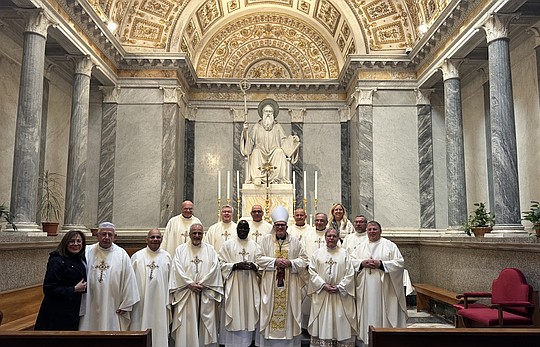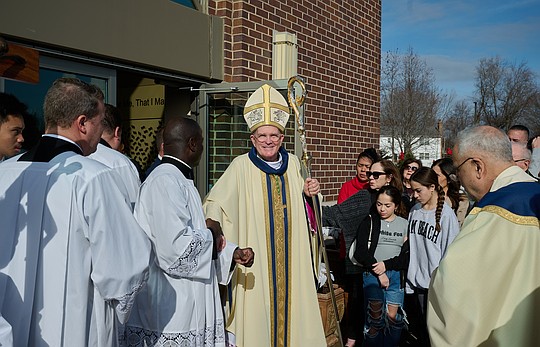Father Koch: At the Transfiguration Jesus shows the fullness of his mission
March 3, 2023 at 3:35 p.m.

The juxtaposition in the Gospel between Jesus’ first indication to his disciples as to the nature of his mission and the Transfiguration reflects both the intentionality of Jesus and the subsequent insight of the evangelists.
The disciples are unprepared for the totality of what is about to unfold before them and must be overwhelmed with Jesus speaking of betrayal and death instead of the fullness of life.
The Transfiguration reveals to his innermost circle -- including the one who on the one hand rejected the mission and on the other denied even knowing him, the fullness of the promise to come.
Yet it is this moment -- one hidden and held in silence in the hearts of each of the men present -- that defines for all time who Jesus is. This is The Christological moment -- a Christophany -- where the Son is fully revealed and realized as that -- the Son, the Second Person of the Blessed Trinity.
In the First Reading, Abram (for he has yet to experience the name change to Abraham) is sent forth, even in his old age, to become the father to a great nation in a land in which he will become an alien. He moves from home -- to alien -- to creating a homeland. This movement reflects the journey of our lives and most certainly mirrors the mission of Jesus. The Son, forsaking all privileges of his divinity, becomes an alien in land which ultimately rejects him, until through his Passion and Death, transforms the totality of creation. He who was an alien is an alien no longer, thereby restoring all of humanity to its former dignity.
[[In-content Ad]]
In the Second Reading from the Second Letter to Timothy, we read: “He saved us and called us to a holy life, not according to our works but according to his own design and the grace bestowed on us in Christ Jesus before time began, but now made manifest through the appearance of our savior Christ Jesus, who destroyed death and brought life and immortality to light through the Gospel.”
The Transfiguration -- literally the total transformation -- of Jesus stands as the intersection of the Incarnation and the Resurrection. As such, it not only burns a constant image on the minds of the witnesses, it provides the basis for their understanding and proclamation of Jesus as Lord and Christ.
St. Peter is often understood here -- as it would seem at first glance that he misreads the moment. Indeed, as St. Augustine observes, Peter gets it fully, and desires to bask in the presence of Christ rather than walk back down the mountain, do the drab ordinariness that awaits them below.
They see Jesus in the fullness of the glory of God. For them this is a foretaste of what is to come: the encounter of the Beatific Vision.
The voice of God, emphasizing anew what was also announced at the Baptism, affirms the Sonship of Jesus, and provides the clarifying answer to the question that Jesus has already asked the disciples: “but who do you say that I am?” While Peter delivered insightfully: “you are the Christ, Son of the living God” he did not yet grasp the fullness of the meaning of what he said. Now, Jesus is revealed to them in all his glory.
Now, they wait for the Son of Man to b e raised from the dead, pondering what that might mean. In keeping with his usual command: “tell no one anything,” Jesus gives the disciples the certainty that what they have seen in a shadow, they will see more clearly and fully at the proper time.
Their testimony to us further enlightens us to the promise. They saw the face of Jesus directly -- gazed into his eyes and beheld his glory. Even Moses, the man closest to God throughout the totality of the Hebrew Scriptures, only ever saw the back of God.
Beholding the face of God and experiencing his glory is the desire of the baptized and the fulfillment of the promises made to Moses, Elijah, and the host of those who believe.
Father Garry Koch is pastor of St. Benedict Parish, Holmdel.
Related Stories
Friday, January 02, 2026
E-Editions
Events
The juxtaposition in the Gospel between Jesus’ first indication to his disciples as to the nature of his mission and the Transfiguration reflects both the intentionality of Jesus and the subsequent insight of the evangelists.
The disciples are unprepared for the totality of what is about to unfold before them and must be overwhelmed with Jesus speaking of betrayal and death instead of the fullness of life.
The Transfiguration reveals to his innermost circle -- including the one who on the one hand rejected the mission and on the other denied even knowing him, the fullness of the promise to come.
Yet it is this moment -- one hidden and held in silence in the hearts of each of the men present -- that defines for all time who Jesus is. This is The Christological moment -- a Christophany -- where the Son is fully revealed and realized as that -- the Son, the Second Person of the Blessed Trinity.
In the First Reading, Abram (for he has yet to experience the name change to Abraham) is sent forth, even in his old age, to become the father to a great nation in a land in which he will become an alien. He moves from home -- to alien -- to creating a homeland. This movement reflects the journey of our lives and most certainly mirrors the mission of Jesus. The Son, forsaking all privileges of his divinity, becomes an alien in land which ultimately rejects him, until through his Passion and Death, transforms the totality of creation. He who was an alien is an alien no longer, thereby restoring all of humanity to its former dignity.
[[In-content Ad]]
In the Second Reading from the Second Letter to Timothy, we read: “He saved us and called us to a holy life, not according to our works but according to his own design and the grace bestowed on us in Christ Jesus before time began, but now made manifest through the appearance of our savior Christ Jesus, who destroyed death and brought life and immortality to light through the Gospel.”
The Transfiguration -- literally the total transformation -- of Jesus stands as the intersection of the Incarnation and the Resurrection. As such, it not only burns a constant image on the minds of the witnesses, it provides the basis for their understanding and proclamation of Jesus as Lord and Christ.
St. Peter is often understood here -- as it would seem at first glance that he misreads the moment. Indeed, as St. Augustine observes, Peter gets it fully, and desires to bask in the presence of Christ rather than walk back down the mountain, do the drab ordinariness that awaits them below.
They see Jesus in the fullness of the glory of God. For them this is a foretaste of what is to come: the encounter of the Beatific Vision.
The voice of God, emphasizing anew what was also announced at the Baptism, affirms the Sonship of Jesus, and provides the clarifying answer to the question that Jesus has already asked the disciples: “but who do you say that I am?” While Peter delivered insightfully: “you are the Christ, Son of the living God” he did not yet grasp the fullness of the meaning of what he said. Now, Jesus is revealed to them in all his glory.
Now, they wait for the Son of Man to b e raised from the dead, pondering what that might mean. In keeping with his usual command: “tell no one anything,” Jesus gives the disciples the certainty that what they have seen in a shadow, they will see more clearly and fully at the proper time.
Their testimony to us further enlightens us to the promise. They saw the face of Jesus directly -- gazed into his eyes and beheld his glory. Even Moses, the man closest to God throughout the totality of the Hebrew Scriptures, only ever saw the back of God.
Beholding the face of God and experiencing his glory is the desire of the baptized and the fulfillment of the promises made to Moses, Elijah, and the host of those who believe.
Father Garry Koch is pastor of St. Benedict Parish, Holmdel.










